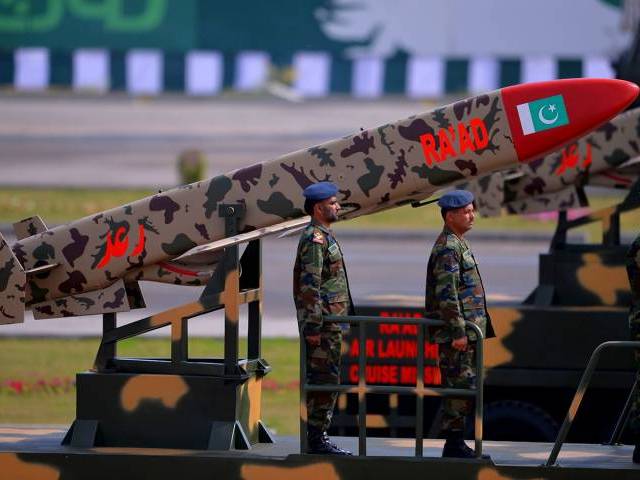

We also cannot ignore the reality that when it comes to India’s nuclear prowess the world powers turn a blind eye. India recently tested the 5,000-km range ballistic missile and the US had no problem with it as it is supposed to counter China’s missile development. In contrast, the US government’s and media’s response to Pakistan’s testing of the submarine launched cruise missile Babar-3 was very negative. Although the rationale for Pakistan is to develop a second strike capability. It would, however, take a decade before Pakistan’s triad capability would be operationalised. The main objective of Pakistan developing Babar-3 is to possess a credible second-strike capability (and fortify its first strike capability) that is sea based, somewhat similar what other major nuclear powers have done in the past. Of course, it is an expensive affair to maintain a triad but Pakistan as in the past has sacrificed a lot to maintain a credible defence against India and likely to do so in the foreseeable future.
Whilst India is being encouraged to develop and operationalise its triad for Pakistan there is clearly a different yardstick. For the US it is primarily a part of its global strategy to build India’s nuclear and conventional capability to partially offset China’s growing strategic power. It is with full blessing and support of the US that India last year was able to join the Missile Technology Control Regime. The same motivation to build India against China is also true for Japan, Britain and most of the Western countries. In sharp contrast, Pakistan’s request for joining the MTCR continues to be denied on one pretext or the other. India by being a member of the MTCR enjoys the benefit of having access to high-end technology and will be able to buy components for its missile programme. The fact that China is not a member of the MTCR there was no opposition to India’s membership. India’s defence minister last year stated that it would be in the country’s interest to abandon the policy of No First Use. By developing a fairly comprehensive Ballistic Missile Defence system in which it had considerable help from Israel and tacit support of Washington it feels confident that it need not pursue the doctrine of NFU. In any case Pakistan has never taken India’s stance on NFU seriously, as it was liable to be altered any time by those in power.
China by design is discreet and keeps silent about India’s nuclear programme. The pressure by the US and the West in general is directed essentially on Pakistan. The line of argument advanced is that Pakistan is not internally stable and the militant outfits like the Lashkar-e-Jhangvi, Lashkar-e-Tayaba and TTP pose a danger to the safety and security of its nuclear arsenal. Pakistan has taken very stringent measures to ensure the safety of its arsenal and is taking very positive steps to neutralise these forces. However, if India continues to brutally crush the genuine indigenous Kashmir resistance movement then despite Pakistan’s best of intentions incidents could occur. Several incidents in the recent past have taken place in India-held Kashmir that were totally indigenous in nature and Indian security forces failed to prevent them. The answer clearly lies in a political dialogue between India and Pakistan and between the Kashmiris and the Indian government.
It was a long awaited but a right decision to ban the organisations that have militant wings and promote insurgency in Kashmir particularly the Jamaat-ud-Dawa and arrest its top leadership. After these actions there is no justification on the part of India to refuse dialogue. Failing to engage enhances the danger of a conflict between the two nuclear neighbours. Moreover, by not talking to Pakistan, India raises the profile of the radical forces in and outside Kashmir. What is most worrying that another terrorist attack irrespective of its origin could lead to a dangerous confrontation and forceful retaliation with its attendant hazards. The US strategic community and the West deliberately or otherwise overlook this aspect.
We have to wait and see what policy does the new Trump administration takes on Pakistan’s nuclear issues. In all likelihood it would be more a continuation of the past policies with minor changes in emphasis. In any case India will not accept any role of the US in the Kashmir dispute. South Asia currently does not seem to be high on the priority list of President Trump.
But President Trump is keen on engaging in a nuclear arms race and had suggested during his election campaign that he would like Japan and other allies develop their own nuclear capability.
On the one hand President Trump wants to improve relations with Russia and does not consider it a threat and on the other plans to keep strengthening US nuclear capability. May be it is directed towards China and also to please the defence establishment that supported him during elections.
Published in The Express Tribune, February 1st, 2017.
Like Opinion & Editorial on Facebook, follow @ETOpEd on Twitter to receive all updates on all our daily pieces.







































COMMENTS (5)
Comments are moderated and generally will be posted if they are on-topic and not abusive.
For more information, please see our Comments FAQ